Ok, this may stir the pot a little, but here it goes. I find it ironic that folks will open up their wallets and drop 2 Gs on a Lambo of an AR15 sporting rifle without breaking a sweat then top it off with a cheap ass optic. Money doesn’t grow on trees; I get it, but let’s be real for a second. Would you buy a high performance car and put cheap tires on it? I hope not. They may last you for a little while but when the rubber really meets the road and the ponies let loose, they will eventually shred under the stresses and forces the car and driver exert on them. Same thing goes for an optic. Will it hold zero after 1000s of rounds? Will it stand up to the stresses of continuous, torturous recoil? Can it withstand getting beat up and knocked around? How will it do in extreme heat, cold and humidity? Will it turn on and stay on when you need it most?
Look, I am not going to knock a guy that has limited funds. Hell, I am one of them. But don’t go cheap because a good optic is “too expensive.” Buy once, cry once. I have quite a few AR15 sporting rifles, but only a fraction of them have optics on them. Why, you may ask? Simple, I don’t buy cheap optics and I ain’t a baller. I will equip my rifles with a good set of back up iron sights (BUIS) then save up for quality glass. Sometimes that takes a long time. Could I outfit every rifle I own with an economical optic? Absolutely. But I personally prefer to wait and save for the optic I really want. Sometimes an economical optic is not a bad thing but for something I want to depend my life on, I will spend the extra coin to get what I feel is right for me. Is there a place for an economic optic in my inventory? Sure. On a plinker rifle, meant for range time fun only. A cheap optic doesn’t belong on a firearm I may one day depend my life on. This is my opinion only. Your mileage may vary.
I am often asked how I set up my AR15 type rifles. My answer may differ depending on the application of the rifle. When it comes to setting up a home defense rifle a single magnification red dot (or similar) is the obvious choice. They can be shot with both eyes open, they are fast and they can be used in conjunction with iron sights. Red dots can be also magnified if needed and they are simple to use under stress. Place the dot on the threat and press the trigger. Repeat steps one and two until the threat is no longer a threat. “Which one should I buy?” is usually the next question. I recommend, support and own a wide variety of optics made by many well-respected manufactures, but when it comes to red dot sights, Aimpoint is at the top of my list. I am not belittling any other red dot manufacture, however I have the more time with Aimpoint red dots and they have worked very well for my shooting preferences.


Aimpoint has been supplying the military with red dot sights for decades now. Their products are tried and true and have tasted the worst mankind can dish out. As technology has advanced, lighter weight red dots have become very popular in both the military and the civilian world. In 2007 Aimpoint developed the Micro Red Dot (MRD). They had three models designated the R-1 (discontinued), H-1 and T-1. All three shared the same physical body, operating controls, and weight, but were designed for different applications. For the hunter and competitor, the H-1 and R-1 were the cheaper options that lacked military features like night vision and more extreme operating parameters. For those wanting the military features the T-1 was the answer.
I break shit. A lot. It is a gift (or a curse). For that reason I bought the Aimpoint T-1. I have owned numerous T-1s and they have never let me down. A 4 MOA T-1 currently sits on my go to, home defense rifle. True story. It runs off a single 3V CR2032 battery and has a stupid long battery life that is calculated in years, not hours. I change the battery once a year, because “Why not?” I don’t have to dismount the optic and mess up the zero to change the battery, which is an added bonus. The T-1 can also withstand serious abuse and still work. Out of its 12 intensity settings, 4 of them are night vision compatible if that is your cup of whiskey. While it has been my go to red dot for years, the T-1 isn’t perfect by any stretch of the imagination.
Originally the T-1 was only available with a 4 MOA (Minute Of Angle) dot. I recently had Lasik eye surgery, but prior to that I had a pretty decent prescription. To make things worse I had a stigmatism in both eyes. I found that the 4 MOA dot appeared to be more of an oval shape rather than a crisp, round dot. This was confirmed by other sight challenged shooters as well as those with healthy eyes. Also the 4 MOA dot becomes a bit large with distance shots and/or when a magnifier is placed behind it. Aimpoint understood this and later developed the smaller 2 MOA dot T-1, which continues to be a great seller for them. The smaller, finer dot helped (but did not eliminate) with my eye issues as well as engaging targets at distance. I also found the T-1 would reflect its LED emitter back to the shooter depending on the light levels, target background and intensity setting of the red dot. What I mean by this is you could actually see the little three pronged emitter reflected in the view window. This can be somewhat distracting. Lastly, it always bothered me that the only way to provide lens protection was to use the flimsy, rubber bikini cover that comes with the T-1. I have broken them in the past and have resorted to buying aftermarket covers that are less than satisfactory in my mind. The T-1, while pretty damn awesome, still needed to be refined.
In 2014 Aimpoint released the T-2. Remember what I said, buy once, cry once? Yeah, this little girl will make you cry. Just a little. She ain’t cheap, but we will get into that later. The T-2 is a single magnification micro red dot that looks similar to the T-1, however it is not just a T-1 upgrade. Upon further examination, it is different. Aimpoint went back to the drawing board and actually listened to the end user to create the T-2.
Aimpoint states their T-2 can withstand extreme temperature swings that range from -50 F to 160 F and is submersible down to 80 feet. This makes it ideal for extreme operating conditions. The T-2’s 3.4 oz anodized aluminum housing is also more robust that the T-1 MRD. It has more reinforcement at the elevation knobs, protecting them from impacts. On the T-1, the protective caps on the adjustment knobs had two nipples used to adjust the optic. The T-2 carries this forward, however only one of the caps has the adjustment feature. Using the cap or provided tool, the T-2 can be adjusted in ½ inch increments at 100 yards.
The Aimpoint T-2 uses the same type of battery as the older T-1 and boasts a 5 year battery life. The intensity adjustment knob is the same, round, knurled knob found on the T-1 with 12 intensity settings and one off setting. Four of the settings are compatible with all current generations of night vision equipment. The adjustment knob also houses the battery just like the T-1. Again, no need to dismount the optic to change the battery.

The optical clarity on the T-2 is clearer than the T-1 and it allows more light back to the shooters eye. This results in better color and light transition and really enhances the 2 MOA dot especially when magnified. While I can’t speak to how it works with an astigmatism, as I didn’t get the T-2 until after my Lasik procedure, the dot appears more round and crisp than the T-1 (at least to me). The housing tube is also sealed providing enhanced protection against the elements. Aimpoint claims that no foreign contaminants will ever enter the T-2 to obstruct the shooter’s sight picture. That’s a pretty big claim… but I bet they can back it up. For added protection, Aimpoint equipped the T-2 with front and rear, clear protective covers that can be flipped up or down. Unlike the old T-1 bikini covers, the T-2 covers stay attached to the optic and can be used in the closed position thanks to the clear plastic lens. The covers secure tightly and seal around the T-2 lenses with a satisfying “click” and they spring out of the way when not needed. Even with the covers in place the T-2 is only 2.4 inches long and 1.6 inches tall (sans mount). This compact size frees up more rail space for mounting BUIS and/or a magnifier. Its slender size also makes it ideal as a secondary optic that can be mounted at an angle or to a larger, magnified piece of glass.
Looking through the T-1, the LED source soldered connections are very visible with the left eye (if shooting right handed). These are located in the lower right hand corner of the optic. Aimpoint did a great job minimizing this in the T-2. When looking down the front of the optic the LED can be seen along with its source. Don’t worry, it is eye safe. Both the T-1 and T-2 share a similar looking three-pronged source however the T-2 is much more subdued which helps with the reflectivity. The T-2 emitter and the anti-reflex lens coating appear to help with the reflection issue noted with the T-1, however it doesn’t completely eliminate it. When looking at a target in really bright conditions, the LED source can still be visible. It should be noted that if that bright light source is concentrated, the light source can/may be reflected in the optic giving the shooter with two or more “red dots” to choose from. This is an issue with the T-1 and some other LED emitter red dots as well, but obviously isn’t ideal.
Like the T-1, the T-2 can be mounted to any firearm (or bow) that has a MIL-STD-1913 Picatinny rail. It will also work with any pistol slide that has been milled to accept the T-2 housing. This means the T-2 can find a home on just about any pistol, rifle, sub gun, laser blaster or phaser on the market.

My short time with the T-2 (yes, it was a loaner) was spent mainly on AR15s and AR10 type rifles. The unit I received was brand new. It came with a mount and variety of spacers to adjust the height. I left the unit on for the two months it was in my possession. As would be expected, there were zero issues with battery failure. I mean, a 50,000-hour battery lifespan is a long time, right? While the recoil on a 5.56, .300 blackout and .308 aren’t stout by any measure the T-2 was rock solid and maintained zero as was to be expected. As it is compatible with older T-1 mounts, I also used it on the variety I had on hand. Using the Aimpoint T-2 was rather… well… boringly reliable. Other than the reflection issues I mentioned above, it worked as advertised and per my expectations. I’ll be honest; I wanted to break it, just to see if I could. I mean, who wouldn’t want to pull a Babe Ruth, point to center field and knock a $760 red dot out of the ball park just to see if it would still work after it returned from orbit? But alas, it wasn’t mine to assault.
Yup, you read it right, the Aimpoint T-2 currently has an average street price of around $760. Look real hard you might be able to knock a few more bucks off. This is the high end of the red dot spectrum but you get what you pay for.

If you are looking for a tough as nails MRD sight that exceeds the ever-popular T-1, the T-2 will do you right. For me personally, I still have an issue with the reflective anomalies in both the T-1 and T-2. Hopefully Aimpoint will one day find a way to clear that up. That being said, I can get over it and will save up for one. Hopefully in the time it takes me to save up the cash, the price will go down a bit. If you are in the market for an Aimpoint Micro Red Dot sight and the T-2 is a bit much for your budget, work toward the Aimpoint T-1. I have no plans to sell mine though, so don’t get any ideas. If you need to save even more cash and don’t require the military capabilities of the T-1 and T-2, try out the Aimpoint H-1. Regardless of your choice, save your pennies and get the optic that is right for you. In this author’s opinion, you can’t go wrong with the Aimpoint Micro Red Dot Family of optics.
* The views and opinions expressed on this web site are solely those of the original authors and contributors. These views and opinions do not necessarily represent those of Guns & Tactics Magazine,
the administrative staff, and/or any/all contributors to this site.


![Holosun 507 Comp Review [Video] Holosun-507-Comp-Review](https://www.gunsandtactics.com/wp-content/uploads/2023/07/Holosun-507-Comp-Review-218x150.jpg)
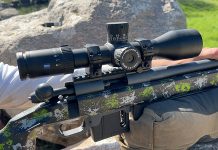
![Holosun 509T Review [Hands-On] Holosun-509T-Review](https://www.gunsandtactics.com/wp-content/uploads/2022/12/Holosun-509T-Review-218x150.jpg)
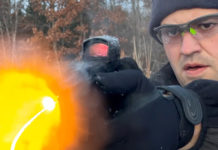
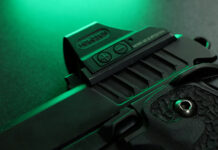
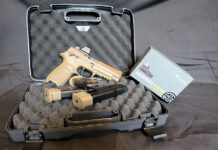
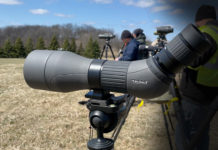

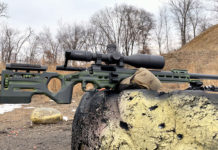
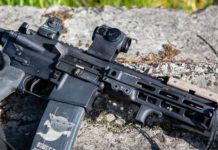
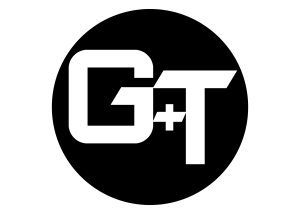
[…] On the right side I mounted an Aimpoint T2 for close up work. I wrote about the T2 in an earlier Guns & Tactics post. I also mounted a Harris bipod to the front of the hand guard. This set up took the rifle from its […]
Comments are closed.